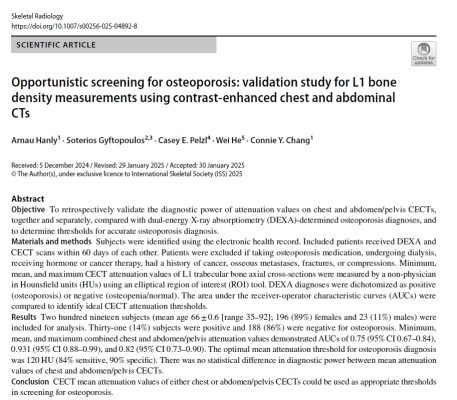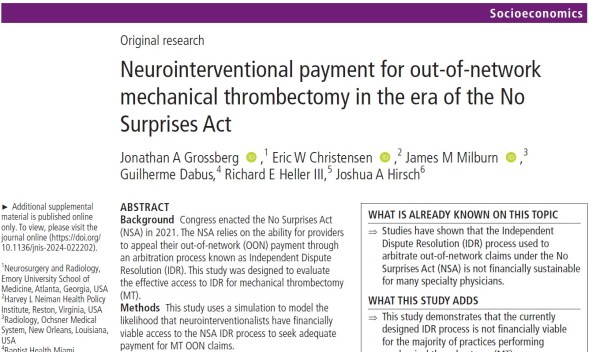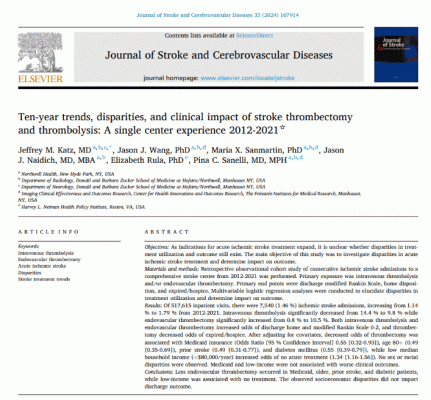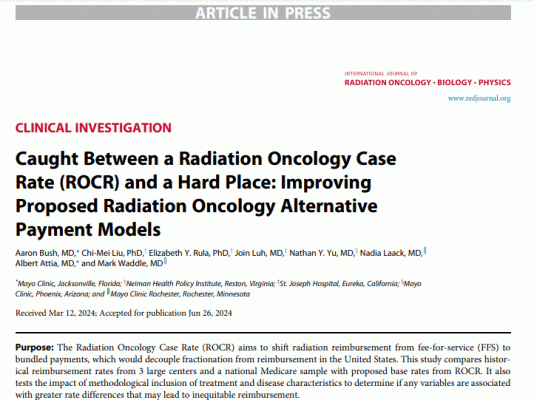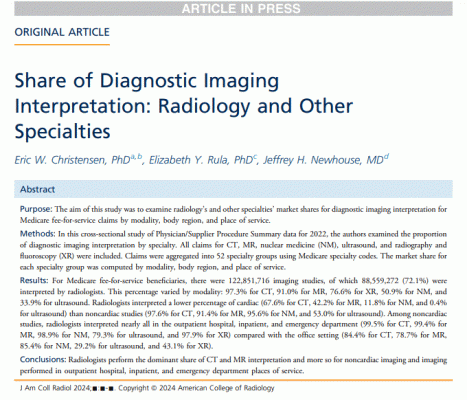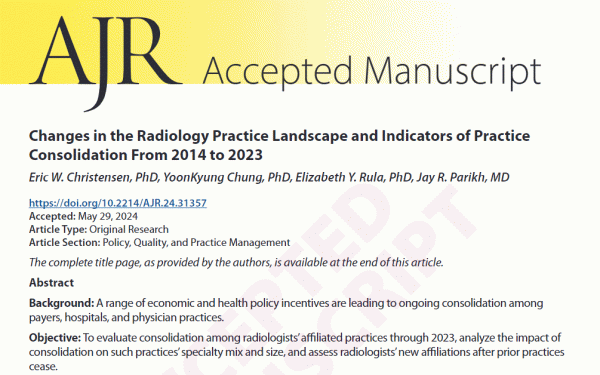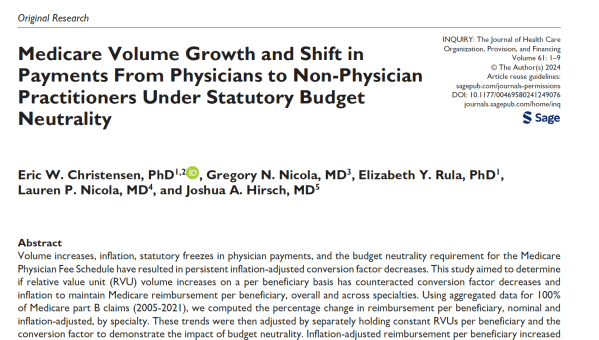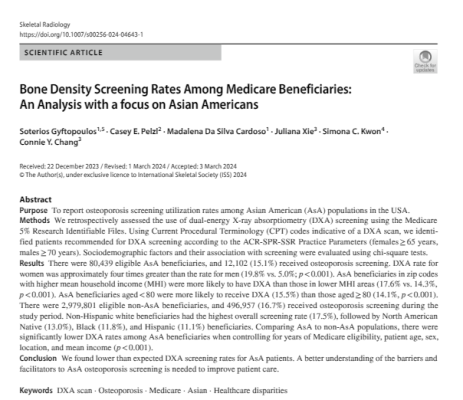To retrospectively validate the diagnostic power of attenuation values on chest and abdomen/pelvis CECTs, together and separately, compared with dual-energy X-ray absorptiometry (DEXA)-determined osteoporosis diagnoses, and to determine thresholds for accurate osteoporosis diagnosis. Full Article
Arnau Hanly, Soterios Gyftopoulos, Casey E. Pelzl, Wei He & Connie Y. Chang. 2025. "Opportunistic screening for osteoporosis: validation study for L1 bone density measurements using contrast-enhanced chest and abdominal CTs," Skeletal Radiology
Congress enacted the No Surprises Act (NSA) in 2021. The NSA relies on the ability for providers to appeal their out-of-network payment through an arbitration process known as Independent Dispute Resolution. This study was designed to evaluate the effective access to IDR for mechanical thrombectomy. Full Article
Jonathan A Grossberg, Eric W Christensen, James M Milburn, Guilherme Dabus, Richard E Heller III, Joshua A Hirsch. 2024. "Neurointerventional payment for out-of-network mechanical thrombectomy in the era of the No Surprises Act," Journal of NeuroInterventional Surgery

For high-risk women, breast magnetic resonance (MR) is the preferred supplemental imaging option, but spatial access differences may exacerbate disparities in breast care. The primary aim of this study was to examine the relative distance to breast imaging facilities with MR compared to facilities offering mammography or ultrasound. Access to advanced imaging modalities is critical for breast cancer outcomes, so better understanding how more local facilities could be harnessed to provide these services is necessary. This study examined for each modality the association of socioeconomic status (as measured by the ADI) and urbanicity with distance to breast imaging facilities to quantify their relationship with distance-related screening access to breast imaging. Full Article
Eric W. Christensen, PhD, Robert B. Rosenblatt, BS, Anika G Patel, Elizabeth Y. Rula, PhD, Ruth C. Carlos, MD, MS, Anand K. Narayan, MD, PhD, Bhavika K. Patel, MD. 2024. "Differential Access to Breast Magnetic Resonance Imaging Compared with Mammography and Ultrasound," American Journal of Preventive Medicine
Socioeconomically disadvantaged neighborhoods are particularly vulnerable to heat-related illnesses. This study aims to investigate the association between the heat vulnerability index (HVI), an established neighborhood-level metric of heat-related mortality risk, and acute ischemic stroke (AIS) severity. Full Article
Jason J. Wang, Jeffrey M. Katz, Maria X. Sanmartin, Liron D. Sinvani, Jason J. Naidich, Elizabeth Y. Rula, and Pina C. Sanelli. 2024. "Association between Heat Vulnerability Index and Stroke Severity," International Journal of Environmental Research and Public Health
As indications for acute ischemic stroke treatment expand, it is unclear whether disparities in treatment utilization and outcome still exist. The main objective of this study was to investigate disparities in acute ischemic stroke treatment and determine impact on outcome. Full Article
Jeffrey M. Katz, MD , Jason J. Wang, PhD, Maria X. Sanmartin, PhD, Jason J. Naidich, MD, MBA, Elizabeth Rula, PhD, Pina C. Sanelli, MD, MPH. 2024. "Ten-year trends, disparities, and clinical impact of stroke thrombectomy and thrombolysis: a single center experience 2012-2021," Journal of Stroke and Cerebrovascular Diseases
The Radiation Oncology Case Rate (ROCR) aims to shift radiation reimbursement from fee-for-service (FFS) to bundled payments, which would decouple fractionation from reimbursement in the United States. This study compares historical reimbursement rates from 3 large centers and a national Medicare sample with proposed base rates from ROCR. It also tests the impact of methodological inclusion of treatment and disease characteristics to determine if any variables are associated with greater rate differences that may lead to inequitable reimbursement. Full Article
Aaron Bush, MD, Chi-Mei Liu, PhD, Elizabeth Y. Rula, PhD, Join Luh, MD, Nathan Y. Yu, MD, Nadia Laack, MD, Albert Attia, MD, and Mark Waddle, MD. 2024. "Caught Between a Radiation Oncology Case Rate (ROCR) and a Hard Place: Improving Proposed Radiation Oncology Alternative Payment Models," International Journal of Radiation Oncology, Biology, Physics
The aim of this study was to examine radiology’s and other specialties’ market shares for diagnostic imaging interpretation for Medicare fee-for-service claims by modality, body region, and place of service. Full Article
Eric W. Christensen, PhD, Elizabeth Y. Rula, PhD, Jeffrey H. Newhouse, MD. 2024. "Share of Diagnostic Imaging Interpretation: Radiology and Other Specialties," Journal of the American College of Radiology (JACR)
A range of economic and health policy incentives are leading to ongoing consolidation among payers, hospitals, and physician practices. The objective of this study is to evaluate consolidation among radiologists' affiliated practices through 2023, analyze the impact of consolidation on such practices' specialty mix and size, and assess radiologists' new affiliations after prior practices cease. Full Article
Eric W. Christensen, PhD, YoonKyung Chung, PhD, Elizabeth Y. Rula, PhD, Jay R. Parikh, MD. 2024. "Changes in the Radiology Practice Landscape and Indicators of Practice Consolidation From 2014 to 2023," American Journal of Roentgenology
Volume increases, inflation, statutory freezes in physician payments, and the budget neutrality requirement for the Medicare Physician Fee Schedule have resulted in persistent inflation-adjusted conversion factor decreases. This study aimed to determine if relative value unit (RVU) volume increases on a per beneficiary basis has counteracted conversion factor decreases and inflation to maintain Medicare reimbursement per beneficiary, overall and across specialties. Full Article
Eric W. Christensen, PhD, Gregory N. Nicola, MD, Elizabeth Y. Rula, PhD, Lauren P. Nicola, MD, Joshua A. Hirsch, MD. 2024. "Medicare Volume Growth and Shift in Payments From Physicians to Non-Physician Practitioners Under Statutory Budget Neutrality," INQUIRY: The Journal of Health Care Organization, Provision, and Financing
To report osteoporosis screening utilization rates among Asian American (AsA) populations in the USA. The study found lower than expected DXA screening rates for AsA patients. A better understanding of the barriers and facilitators to AsA osteoporosis screening is needed to improve patient care. Full Article
Soterios Gyftopoulos, Casey E. Pelzl, Madalena Da Silva Cardoso, Juliana Xie, Simona C. Kwon & Connie Y. Chang. 2024. "Bone Density Screening Rates Among Medicare Beneficiaries: An Analysis with a focus on Asian Americans," Skeletal Radiology

